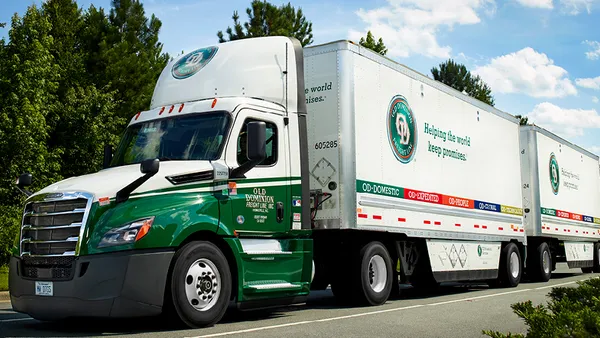NASHVILLE, Tenn. — In the Music City, there was music to shippers' ears.
"We are past the peak" in the trucking industry, Noel Perry, principal at Transport Futures, said at the Council of Supply Chain Management Professionals' (CSCMP) Edge 2018 conference. "We're headed down. The question is how fast and how far."
During a session on transportation and logistics, panelists asked the audience if they felt the industry had entered a "new normal." Attendees overwhelmingly said yes.
The trend is evident in recent statistics, too. New orders of trucks are consistently setting and breaking previous months' records, and total expenditures on truck transportation are up nearly 17% over last year. Carriers are offering as many incentives as they can to add new drivers to their ranks and retain the ones they already have.
Hours-of-service enforcement through the electronic logging device (ELD) mandate have further exacerbated availability problems in the trucking industry. In the fourth quarter of 2017, when the ELD mandate took effect, the market needed to add 100,000 drivers, Perry said.
Finding all of those drivers, however, is easier said than done.
"We don't have a driver shortage," said Brent Nussbaum, CEO of Nussbaum Transportation. "We have a shortage of qualified drivers."
As a carrier, Nussbaum said he often receives applications from people with poor driving records. On average, carriers hire only 2% of the drivers that apply, according to Kevin Abbott, vice president of truckload at C.H. Robinson.
Of the drivers that are brought on board, retaining them is another challenge, as turnover in the industry is extremely high. The average driver salary, according to Bureau of Labor Statistics data, was $42,500 in 2017. Nussbaum said he thinks truckers need an annual salary of around $85,000 to keep them from leaving the industry.
The high demand for truck drivers and low available supply to fulfill the demand has created a significant imbalance in the supply chain.
Adding to that, shippers are not always utilizing the capacity they do have in an optimal way, said Adam Hall, vice president of transportation at L'Oreal. Customers often demand goods quickly and will penalize shippers with fines if they're late, which means shippers aren't waiting to send full truckloads. Hall said too many trucks are traveling on the road with small loads — or are even empty.
"A New Normal? Today's Trucking Environment" is a hot topic our own Kevin Abbott discuss while at @cscmp with Steve Raetz moderating. #cscmpedge pic.twitter.com/u9q8UIhr6w
— C.H. Robinson (@CHRobinsonInc) October 2, 2018
The crunch and inefficient use of capacity has fundamentally altered how many carriers do business, Nussbaum said. While carriers used to plan their routes and schedules around a shipper's needs, now it revolves around driver availability.
In this environment, it's more important than ever for shippers to have strong relationships with their carriers and position themselves as the shipper of choice.
"It's time to change our approach" to transactions with carriers, Hall said. Some shippers will continue to use the strategy of "buy low," but Hall said a more effective approach is to have an active relationship with the carrier.
Such a relationship is coveted by the carrier, as well. Panelists said both parties value the security and dependability of having relationships with one another.
"We've entered a time period where collaboration is more important than ever," Abbott said.















